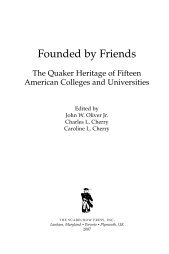Separate Realities: The Dream and the Iceberg - Scarecrow Press
Separate Realities: The Dream and the Iceberg - Scarecrow Press
Separate Realities: The Dream and the Iceberg - Scarecrow Press
You also want an ePaper? Increase the reach of your titles
YUMPU automatically turns print PDFs into web optimized ePapers that Google loves.
50 Chapter 2<br />
increased substantially while “social mobility” from lower <strong>and</strong> middle incomes<br />
to higher-income ranks “seems to have stagnated.” 21 <strong>The</strong> series also<br />
noted that <strong>the</strong> advantages of privileged-class-based family membership—<br />
more so than merit alone—now have become (much more so than in <strong>the</strong><br />
past) centrally important in ensuring <strong>the</strong> continued distribution of high levels<br />
of economic rewards to privileged-class members. Despite <strong>the</strong>se trends, <strong>the</strong> series<br />
reassured middle-class readers that mobility is still possible by including<br />
profiles of individuals who have “moved up.”<br />
Following <strong>the</strong> series, <strong>the</strong> Times published an editorial that assured concerned<br />
middle-class readers that <strong>the</strong> paper was on <strong>the</strong>ir side. This piece argued<br />
in favor of “a truly merit-based society where class finally fades from<br />
importance.” 22 While <strong>the</strong> Times’ editorial sentiment may be laudable, in <strong>the</strong><br />
absence of structural changes that would reduce privileged-class advantages,<br />
members of <strong>the</strong> working <strong>and</strong> middle classes are left in <strong>the</strong> same powerless<br />
<strong>and</strong> disadvantaged position as was <strong>the</strong> case when <strong>the</strong> Times profiled <strong>the</strong>ir<br />
plight nine years earlier in its “Downsizing of America” series. <strong>The</strong>n, as now,<br />
in <strong>the</strong> final analysis, <strong>the</strong> central focus of each series was not on class-based<br />
policy reforms but on individual effort. In <strong>the</strong> mid-1990s, “<strong>The</strong> lesson, heard<br />
again <strong>and</strong> again, [was] that while government <strong>and</strong> business can do some<br />
things, in <strong>the</strong> end workers have little to fall back on but <strong>the</strong>mselves.” 23 In <strong>the</strong><br />
mid-2000s, <strong>the</strong> “lesson” was get an education! While <strong>the</strong> Times editorial favored<br />
some programs facilitating greater access to college for low-income<br />
groups, <strong>the</strong> unstated message (lesson) was that in <strong>the</strong> meantime, working- or<br />
middle-class individuals interested in improving <strong>the</strong>ir lot in life should find<br />
ways to advance <strong>the</strong>ir education. 24<br />
<strong>The</strong> second exception to avoidance of class issues includes mass media<br />
glimpses into <strong>the</strong> lives of <strong>the</strong> privileged class, as well as tours of <strong>the</strong> excluded<br />
class. 25 Television programs often take viewers to both destinations. <strong>The</strong> glamour<br />
of life at <strong>the</strong> top is routinely showcased on both conventional <strong>and</strong> tabloidstyle<br />
TV newsmagazines (e.g., 60 Minutes, 20/20, Entertainment Tonight, Inside<br />
Edition); such programs frequently broadcast profiles of wealthy entertainment<br />
<strong>and</strong> sports figures, along with occasional reports on charismatic corporate<br />
elites. <strong>The</strong> grim realities of life-at-<strong>the</strong>-bottom experiences turn up most often<br />
on occasional PBS or cable TV documentaries concerning poverty, homelessness,<br />
welfare, <strong>and</strong> related issues.<br />
Sometimes <strong>the</strong> plight of <strong>the</strong> poor becomes <strong>the</strong> focus of mainstream media<br />
attention—as in <strong>the</strong> aftermath of Hurricane Katrina, which stuck New Orleans<br />
<strong>and</strong> <strong>the</strong> U.S. Gulf coast on August 29, 2005. In this instance, dramatic television<br />
<strong>and</strong> print media coverage of rescues <strong>and</strong> government relief miscues focused<br />
public attention on <strong>the</strong> widespread <strong>and</strong> intense suffering of <strong>the</strong> poor. 26<br />
But <strong>the</strong> attention was short-lived. Despite occasional media reports in <strong>the</strong> following<br />
weeks encouraging <strong>the</strong> allocation of more public resources to deal with<br />
<strong>the</strong> problems of poverty, by October <strong>the</strong> plight of <strong>the</strong> poor, as laid bare by Katrina,<br />
had begun to fade from media, government, <strong>and</strong> public attention as <strong>the</strong>
















